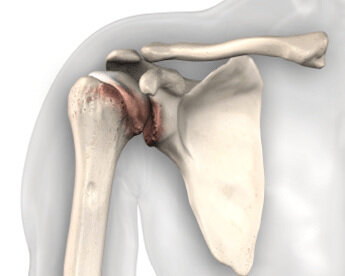Shoulder Arthritis.
The shoulder is a ball and socket joint. The ball is on the top of the arm bone (the humerus), the socket (also known as the glenoid) is attached to the side of the shoulder blade. Normally the ball and socket are lined with smooth cartilage that provides a pain free and fiction free surface for movement.
In arthritis the smooth cartilage is worn away to expose the rough bone underneath. As more cartilage is worn away the rubbing of the bone surfaces cause pain and stiffness.
Arthritis can often progress to the extent where the shoulder will barely move and be painful even at rest.
What causes shoulder arthritis?
Various types of arthritis exist, the most common of which is osteoarthritis. This has been traditionally thought of as ‘wear and tear’ but more realistically it can be thought of as a combination of genetic and environmental factors. You are more likely to experience osteoarthritis if there is a family history of arthritis or if you have any contributing factors such as: previous trauma, shoulder surgery and shoulder overuse.
Inflammatory arthritis is a family of conditions in which your immune system starts attacking your own tissues, which can cause pain, stiffness and joint damage. Multiple joints are often affected and patients are usually aware of their condition before the shoulder becomes involved. If this is the cause of your arthritis it is vital that the condition is first treated with specific medication before surgical treatments are considered.
How is shoulder arthritis diagnosed?
Usually Mr Moverley can diagnose arthritis with a combination of clinical examination and a careful assessment of the history of your symptoms. As shoulder arthritis can be confused with other conditions such as frozen shoulder, further diagnostic tests are used for confirmation and to plan treatment:
X-rays can be obtained on the day of your consultation and may demonstrate irregular joint surfaces and bone loss.
MRI/Ultrasound maybe requested to assess if there is any damage to the rotator cuff (the tendons surrounding the shoulder).
CT scans are usually obtained if shoulder replacement is indicated as they allow 3-D computer planning of your surgery.
Treatment options
Often the severity of your symptoms and the impact of arthritis on your daily activities do not correlate with the severity of the arthritis observed on x-rays. It is therefore crucial that treatment is tailored specifically to your symptoms whilst taking into account your expectations and medical history.
Non-operative Management
Non-operative treatment should always be exhausted before considering any form of surgery. Possible non-operative options include:
A focused physiotherapy program to strengthen the muscles around the shoulder can prevent any further stiffness and help regain range of motion. This will prove beneficial even of surgery is eventually indicated.
Rest, activity modification, and simple pain relief can provide good benefit, particularly in the early stages of the disease.
Steroid injections are often used to provide short-term relief, which can then allow you to participate in physiotherapy. Repeated injections should not be given as a long-term cure as they may cause further damage to the joint.
Hyaluranon injections have been shown to be beneficial for early arthritis and where surgery is contraindicated. They can (but not always) provide longer benefit than steroid injections with fewer side effects. However, they are more costly and again are not curative.
Surgical Management
There are various surgical options available, Mr Moverley will discuss if these are likely to be beneficial for your specific needs.
Shoulder Arthroscopy
Arthroscopic treatment of the shoulder for osteoarthritis is primarily a temporary therapy in which the joint is "tidied up." Mr Moverley will remove unwanted material and smooth off the joint, which can provide relief of symptoms. This treatment has only been shown to work in the early stages of arthritis and typically will delay eventual shoulder replacement for 2 years. In reality, relatively few patients meet the criteria for shoulder arthroscopy in arthritis.
Shoulder replacement
In cases of severe pain or previous failed treatment options, arthroplasty (shoulder replacement) can be considered. There are multiple variations for shoulder replacement and Mr Moverley will propose the optimum type for you based on your age, activity level, form of arthritis, and the amount of bone affected.

